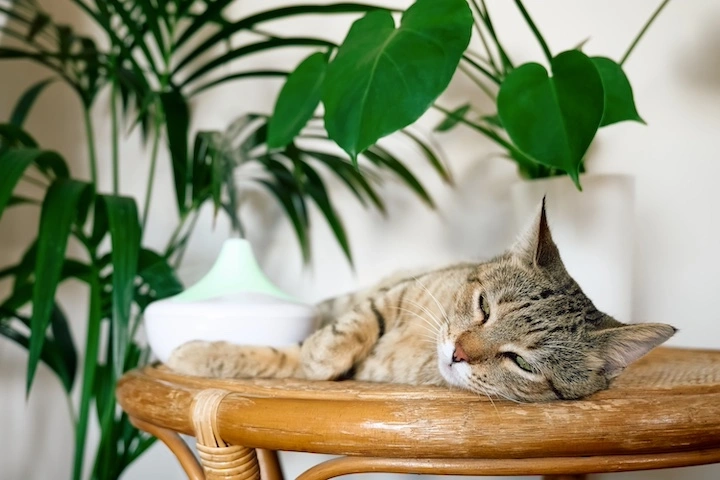
05 septembre 2024
Aromatherapy and animal health
Veterinary aromatherapy has experienced considerable growth in recent years, establishing itself as an innovative complementary approach in the field of animal health. This practice, which utilizes the therapeutic properties of essential oils, offers new perspectives for improving the well-being of our four-legged companions.
Whether you are a veterinarian seeking to expand your range of care or an animal owner passionate about natural methods, this guide will immerse you in the heart of veterinary aromatherapy. We will explore its fundamental principles, advantages, limitations, as well as safe and effective protocols for various common ailments.
What you will discover in this guide
If you don't have time to read the entire guide, here is a summary of the three main points you will find in this article on veterinary aromatherapy:
1- Principles and benefits of veterinary aromatherapy
The article explains the foundations of veterinary aromatherapy, defining what an essential oil is and how it acts on animals. It highlights the potential advantages of this approach, particularly for managing stress, relieving pain, treating certain skin problems, and strengthening the animals' immune system. Readers will discover how this method can complement conventional veterinary treatments.
2- Recommended essential oils and their uses
The guide presents a selection of essential oils particularly useful in veterinary medicine, such as True Lavender, Tea Tree, Lemon-scented Eucalyptus, and Roman Chamomile. For each essential oil, the article details its specific properties and common applications in animals. Readers will learn which essential oils to use for specific problems such as anxiety, skin infections, or joint pain.
3- Precautions for use and safe application methods
Particular emphasis is placed on the importance of using essential oils safely and responsibly in animals. The article stresses the need to always dilute essential oils, respect recommended dosages, and consult a specialized veterinarian before any use. It also explains the different application methods (cutaneous, diffusion, oral under veterinary supervision) and specific precautions to take depending on the animal species, with particular attention to cats, which are more sensitive to essential oils.
This summary provides an overview of key information guiding you towards an informed and safe use of aromatherapy for companion animals.

Basic principles of veterinary aromatherapy
What is an essential oil?
An essential oil is a liquid concentrate of volatile aromatic compounds extracted from plants. Unlike vegetable oils, essential oils are not greasy and evaporate quickly in open air. They are obtained by steam distillation or cold expression for citrus fruits.
These essential oils contain numerous active biochemical molecules, each with specific therapeutic properties. For example, linalyl acetate present in True Lavender has calming and sedative effects, while citronellal from Lemon Eucalyptus possesses anti-inflammatory and hypotensive properties.
How do essential oils work in animals?
Essential oils act on animals mainly through two pathways:
1- Olfaction: Aromatic molecules are captured by olfactory receptors and transmitted directly to the limbic system, thus influencing emotions and certain physiological functions.
2- Cutaneous or oral absorption: Active compounds penetrate the body through the skin or digestive mucous membranes, then are transported by blood to target organs.
It is crucial to note that animals, especially dogs and cats, have a much more developed sense of smell than humans. This generally makes them more sensitive to the effects of essential oils, even at low concentrations.
Advantages and limitations of aromatherapy in veterinary medicine
Benefits for animal health
Veterinary aromatherapy offers numerous advantages:
- Holistic approach: It considers the animal in its entirety, aiming to restore balance rather than merely treating symptoms.
- Multiple effects: A single essential oil can have several therapeutic actions (for example, antiseptic and healing).
- Complementarity: It can be used in synergy with conventional treatments to enhance their effects.
- Reduction of side effects: When properly used, essential oils generally cause fewer adverse effects than some synthetic medications.
Precautions and contraindications
Despite its benefits, veterinary aromatherapy has certain limitations:
- Increased sensitivity: Animals being more sensitive to essential oils than humans, the risk of overdose is higher.
- Animal species to avoid in veterinary aromatherapy: The potency of essential oils is such that it would not be tolerated by small animals such as birds, fish, reptiles, and small rodents. Particular caution is needed when diffusing essential oils in the presence of birds. However, animals that fully benefit from aromatherapy are dogs, cats, and farm animals such as horses, cows, and pigs.
- Specific toxicity: Some essential oils safe for humans can be toxic to animals, particularly cats who lack specific hepatic enzymes to metabolize certain compounds. Thus, it is advisable to avoid offering them orally essential oils rich in phenols or ketones, such as essential oils of Atlas Cedar (Cedrus atlantica), Peppermint (Mentha x piperita), or Rosemary verbenone (Rosmarinus officinalis verbenoniferum).
- Lack of clinical studies: Although more and more research is being conducted, scientific evidence of the efficacy of veterinary aromatherapy remains limited for certain conditions.
It is therefore essential to always consult a veterinarian trained in aromatherapy before using essential oils on an animal.
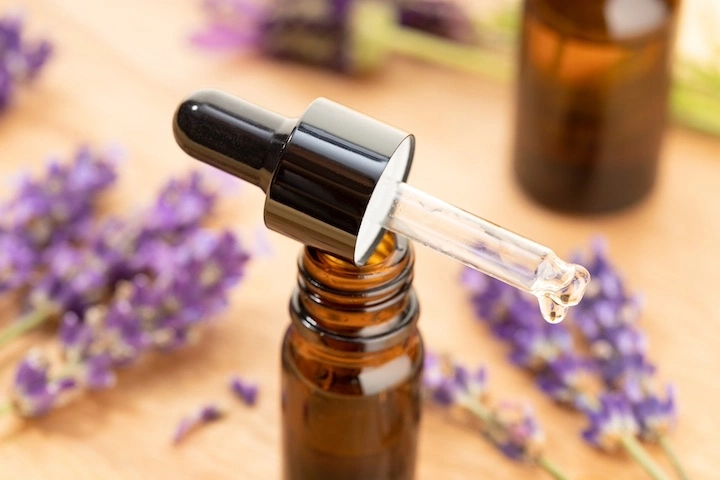
The most used essential oils in veterinary medicine
1- True Lavender (Lavandula angustifolia)
True Lavender is one of the most versatile and safe essential oils in veterinary aromatherapy. Thanks to its richness in linalool and linalyl acetate, its main properties are:
- Cutaneous anti-inflammatory
- Calming and anxiolytic
- Healing and skin regenerative
- Antispasmodic
Common uses: stress, anxiety, skin problems, minor wounds.
2- Tea Tree (Melaleuca alternifolia)
Tea tree essential oil is renowned for its powerful antimicrobial properties due to its concentration of terpenes. However, its use requires special precautions, especially in cats.
Among its main properties:
- Antimicrobial
- Immunostimulant
- Antifungal and antiviral
- Internal and external antiparasitic
Common uses: infections in general, skin infections, otitis, dermatophytosis.
3- Peppermint (Mentha x piperita)
Rich in menthol and menthone, Peppermint essential oil is appreciated for its refreshing and analgesic effects. Due to its concentration of ketones, it must be used with caution and always diluted.
Among its main properties, the following stand out:
- Analgesic with cooling effect
- Digestive tonic
- Antiviral and antiseptic
- Antipruritic
- Anti-inflammatory
Common uses: muscle and joint pain, nausea, digestive fatigue, itching.
4- Lemon Eucalyptus (Eucalyptus citriodora)
Uniquely rich in citronellal and citronellol, Lemon Eucalyptus essential oil is particularly useful for joint problems and insect repellent.
It is recognized for the following properties:
- Anti-inflammatory
- Calming and relaxing
- Insect repellent
Common uses: osteoarthritis, joint pain, itching, protection against ticks and fleas.
5- Roman Chamomile (Anthemis nobilis)
Roman Chamomile essential oil is recognized for its gentle soothing and anti-inflammatory properties, notably due to its content of isobutyl angelate.
It is primarily chosen for its properties:
- Calming and sedative
- Anti-inflammatory
- Anti-allergic and antipruritic
- Analgesic
Common uses: stress, anxiety, skin irritations.
6- Summary table
To summarize and provide a practical overview, here is a table detailing the main essential oils used in veterinary medicine, their applications, precautions for use, and recommended dosages:
|
Essential oil |
Animals concerned |
Pathology |
Precautions for use |
Dosage |
|
True Lavender (Lavandula angustifolia) |
Dogs, Horses |
Stress, anxiety |
Dilute before use. |
Diffusion or Dilution of 2-3% in a gel or cream and local application 2 times/day |
|
Tea tree (Melaleuca alternifolia) |
Dogs |
Skin infections |
Dilute before use. |
Dilution of 5% in a gel or cream, local application 2-3 times/day |
|
Roman Chamomile (Anthemis nobilis) |
Dogs, Horses |
Dermatitis, Anxiety |
Avoid oral and diffusion routes. |
Dilution of 5% in a gel or cream, local application 1-2 times/day |
|
Lemon Eucalyptus (Eucalyptus citriodora) |
Dogs, Horses |
Joint pain |
Avoid in epileptic animals. |
Dilution of 5% in a gel or cream, local application 2-3 times/day |
|
Sweet Wintergreen (Gaultheria fragrantissima) |
Dogs, Horses |
Tendinitis, Rheumatism, Cramps |
Avoid oral and diffusion routes. |
Dilution of 5% in a gel or cream, local application 1-2 times/day |
|
Ravintsara (Cinnamomum camphora) |
Dogs, Cats |
Immune strengthening, Fatigue |
Well tolerated regardless of the route of use. |
Diffusion and/or 1-2 pure drops applied to the spine 1 to 3 times/day |
|
Peppermint (Mentha x piperita) |
Dogs (adults) |
Motion sickness, Nausea, Digestive fatigue, Pain |
Do not use in cats. May irritate mucous membranes. |
1 diluted drop in a teaspoon of vegetable oil to impregnate in kibbles, Dilution of 1% in a gel or cream and local application 2 times/day |
General precautions for all essential oils:
- Always consult a veterinarian specialized in aromatherapy before use.
- Do not use in animals under 3 months old, pregnant or lactating females.
- Start with low doses and carefully observe the animal's reaction.
- Avoid application near eyes, nose, ears, and mucous membranes.
- Allow the animal to leave the room in case of atmospheric diffusion.
- Be particularly vigilant with cats, who are very sensitive to essential oils.
- Always dilute essential oils before application.
- Stop use immediately in case of adverse reaction.
This table provides an overview of common uses of essential oils in veterinary medicine. However, it is crucial to remember that each animal is unique and that the use of essential oils should always be done under the supervision of a veterinarian specialized in aromatherapy.
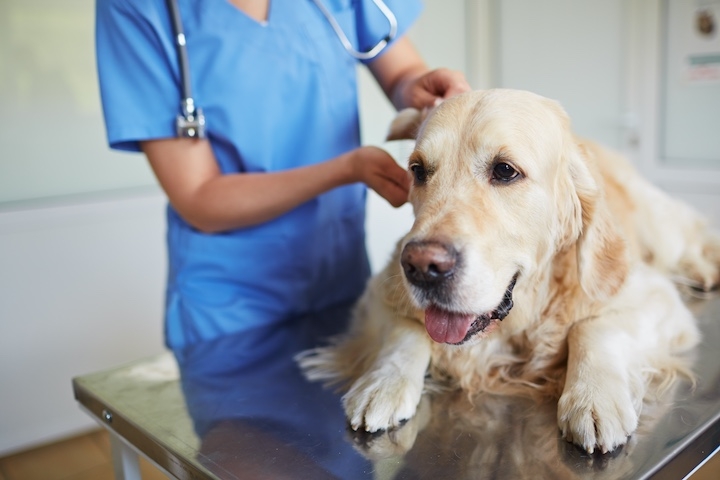
Methods of applying essential oils to animals
Cutaneous application
Cutaneous application is the most common method in veterinary aromatherapy. It allows for a gradual absorption of active ingredients through the skin.
Protocol:
- Always dilute the essential oil in a carrier oil (maximum 1 to 5% essential oil).
- Apply the mixture with a gentle massage on the affected area or on acupuncture points.
- For general action, favor areas with little hair such as the inside of the paws or paw pads.
Atmospheric diffusion
Diffusion allows for the benefits of essential oils through inhalation, particularly effective for respiratory and behavioral issues.
Precautions:
- Use a diffuser suitable for animals (cold nebulization diffusion).
- Limit diffusion duration (15-30 minutes maximum, 2-3 times per day).
- Always leave a door open so the animal can leave the room if desired.
Oral administration (under veterinary supervision)
Oral administration should be reserved for specific cases and always under veterinary supervision due to toxicity risks.
Method:
- Dilute the essential oil in a carrier oil.
- Mix with food.
- Strictly adhere to dosages prescribed by the veterinarian.
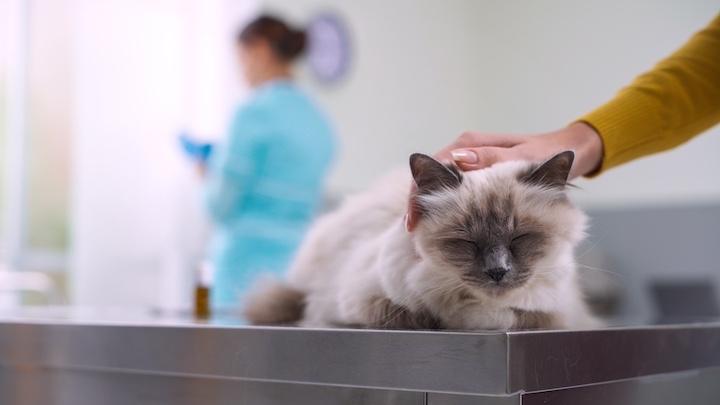
Protocols for common ailments
1- Dermatological problems
Allergic dermatitis:
- Mixture: 1 drop of True Lavender essential oil (Lavandula angustifolia) + 1 drop of Roman Chamomile (Anthemis nobilis) in 5 ml of Marigold macerate (Calendula officinalis).
- Application: Twice daily on affected areas for 5-7 days.
Superficial wounds:
- Mixture: 1 drop of Tea Tree essential oil (Melaleuca alternifolia) + 1 drop of True Lavender (Lavandula angustifolia) in a dab of healing cream.
- Application: 1-2 times daily on the cleaned wound until healed.
2- Digestive issues
Nausea and vomiting:
- Mixture: 1 drop of Peppermint essential oil (Mentha x piperita) + 1 drop of Ginger (Zingiber officinale) in 1 teaspoon of carrier oil to be dispersed on kibbles.
- Administration: 1-2 times daily for up to 2-3 days as needed (under veterinary supervision).
Mild diarrhea:
- Mixture: 1 drop of Cinnamon essential oil (Cinnamomum verum) + 1 drop of Tea Tree (Melaleuca alternifolia) in 1 teaspoon of carrier oil to be dispersed on kibbles.
- Administration: 1-2 times daily for 2-3 days (under veterinary supervision).
3- Stress and anxiety
Separation anxiety:
- Diffusion: 3 drops of True Lavender essential oil (Lavandula angustifolia) + 2 drops of Petitgrain (Citrus aurantium amara) in a diffuser 30 minutes before departure.
- Application: 1 drop of the same mixture on a bandana or toy to leave with the animal.
Travel-related stress:
- Mixture: 1 drop of True Lavender essential oil (Lavandula angustifolia) + 1 drop of Roman Chamomile (Anthemis nobilis) in 5 ml of carrier oil.
- Application: On the spine 15 minutes before departure.
4- Joint pain
Osteoarthritis:
- Mixture: 2 drops of Lemon Eucalyptus essential oil (Eucalyptus citriodora) + 1 drop of Sweet Wintergreen (Gaultheria fragrantissima) in 10 ml of Arnica macerate (Arnica montana).
- Application: Light massage on painful joints 1-2 times daily.
Post-exercise inflammation:
- Mixture: 1 drop of Peppermint essential oil (Mentha x piperita) + 1 drop of Lemon Eucalyptus (Eucalyptus citriodora) in 5 ml of St. John's Wort macerate.
- Application: Massage after physical exertion.
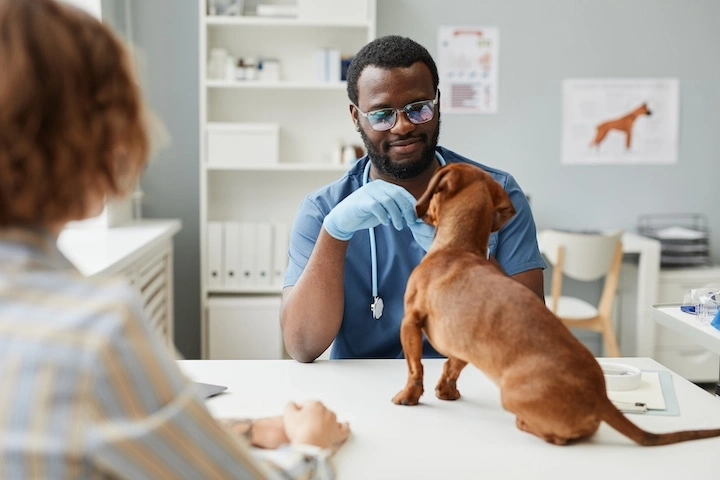
Precautions and safety
Recommended dilutions
Diluting essential oils is crucial to avoid risks of toxicity and irritation. Recommended dilution rates vary according to species, animal size, and application area. Generally:
- Dogs: 0.5% to 2% (1 to 4 drops of essential oil per 10 ml of carrier oil)
- Cats: 0.1% to 0.5% (1 to 2 drops per 20 ml of carrier oil)
- Horses: 1% to 3% (2 to 6 drops per 10 ml of carrier oil)
Potential toxicity
Some essential oils are particularly toxic to animals and should be avoided, especially those containing ketones:
- Atlas Cedar (Cedrus atlantica)
- Spearmint (Mentha spicata)
- Rosemary camphor (Rosmarinus officinalis camphoriferum)
- Rosemary verbenone (Rosmarinus officinalis verbenoniferum)
- Common Sage (Salvia officinalis)
Signs of toxicity to watch for include: vomiting, diarrhea, lethargy, respiratory difficulties, tremors. If intoxication is suspected, consult a veterinarian immediately.
Drug interactions
Essential oils can interact with certain medications, potentiating or diminishing their effects. For example:
- Essential oils with anticoagulant properties (such as Ginger) can increase the risk of bleeding in animals on anticoagulants.
- Some essential oils can interfere with the hepatic metabolism of drugs, altering their efficacy.
It is therefore imperative to inform the veterinarian of any ongoing treatment before using essential oils.
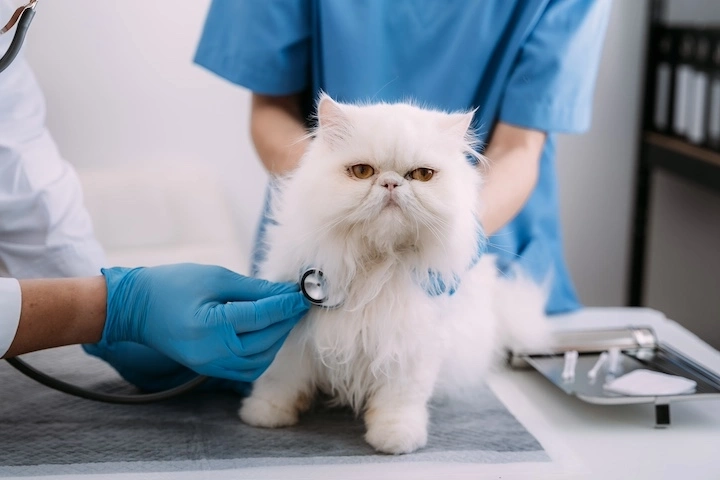
Veterinary aromatherapy in professional practice
Integration into a veterinary practice
Incorporating aromatherapy into a veterinary practice requires:
- Comprehensive training: Undertake specialized courses in veterinary aromatherapy to master protocols and safety precautions.
- Appropriate equipment: Invest in therapeutic-grade essential oils and specific materials (diffusers, dilution vials).
- Client communication: Elucidate the benefits and limitations of aromatherapy, and provide detailed instructions for home use.
- Rigorous follow-up: Implement a monitoring system to evaluate the efficacy of aromatherapy treatments.
Training and regulation
While training in veterinary aromatherapy is not yet standardized, several options exist:
- Continuing education offered by specialized schools
- Seminars and conferences organized by professional associations
- University curricula incorporating veterinary aromatherapy modules
From a regulatory standpoint, the use of essential oils in veterinary medicine remains largely unregulated. It is the veterinarian's responsibility to ensure the safety and efficacy of the protocols employed.
A promising future for veterinary aromatherapy
In conclusion, veterinary aromatherapy represents a promising and complementary approach in the realm of animal health. Essential oils, when used with caution and expertise, offer a wide array of benefits for our four-legged companions, ranging from stress alleviation to skin problem management and joint pain relief.
However, it is crucial to emphasize that this practice requires profound knowledge and great prudence. Animal owners and veterinarians interested in aromatherapy must adequately train themselves and stay informed of the latest research in this constantly evolving field.
The future of veterinary aromatherapy appears promising, with growing interest from both professionals and the public. More extensive scientific studies will be necessary to fully validate its efficacy and establish standardized protocols. In the meantime, a balanced approach, combining conventional medicine and aromatherapy under professional supervision, can offer natural and effective solutions to improve the health and well-being of our companion animals.
Some reference websites
- Veterinary Medical Aromatherapy Association (VMAA): https://vmaa.vet/
- National Association for Holistic Aromatherapy - Animal Aromatherapy: https://naha.org/explore-aromatherapy/about-aromatherapy/animals-aromatherapy/
Items that could
interest
Our essential oils
will simplify your life
FAQ
As a customer of the Landema website, did you know that we also have a physical store? If you live in the Landes, in New Aquitaine or are planning to stay there, do not hesitate to visit us! We are located in Le Sen, on the Biolandes site, very close to Labrit, Roquefort, and Mont-de-Marsan, in the heart of the Landes de Gascogne regional natural park.
Essential oils are natural aromatic substances extracted from plants. They are often used in aromatherapy for their health and wellness benefits. Essential oils can be extracted from different parts of plants, such as leaves, flowers, barks, roots or seeds. The use of essential oils dates back to ancient times, where they were used for their medicinal properties and to perfume cosmetics and skincare products.
Landema invites you to discover our product range composed of essential oils, absolutes, vegetable oils, macerates or hydrosols. Our catalog will grow over time, stay informed by subscribing to our newsletter.
We invite you to discover our practical guides and our blog where you can discover our advice and our cases of use of essential oils.
Your wishlist
You must be logged in to post a comment.
Login, or create an account
There is no comment for this article yet